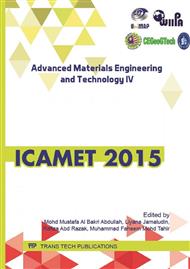[1]
Duxson, P., G.C. Lukey, and J.S.J. v. Deventer, Physical evolution of Na-geopolymer derived from metakaolin up to 1000 °C. J Mater Sci, 2007. 42: pp.3044-3054.
DOI: 10.1007/s10853-006-0535-4
Google Scholar
[2]
Xu, H. and J.S.J.V. Deventer, Microstructural characterisation of geopolymers synthesised from kaolinite/stilbite mixtures using XRD, MAS-NMR, SEM/EDX, TEM/EDX, and HREM. Cement and Concrete Research, 2002. 32: pp.1705-1716.
DOI: 10.1016/s0008-8846(02)00859-1
Google Scholar
[3]
Sagoe-Crentsil, K. and L. Weng, Dissolution processes, hydrolysis and condensation reactions during geopolymer synthesis: Part II. High Si/Al ratio systems. Advances in Geopolymer Science and Technology, 2007. 42: pp.3007-3014.
DOI: 10.1007/s10853-006-0818-9
Google Scholar
[4]
Bell, A.T., NMR applied to zeolite synthesis. Colloids and Surfaces A: Physicochemical and Engineering Aspects 1999. 158: pp.221-234.
DOI: 10.1016/s0927-7757(99)00149-1
Google Scholar
[5]
Bondar, D., et al., Effect of type, form, and dosage of activators on strength of alkali-activated natural pozzolans. Cement & Concrete Composites, 2011. 33: pp.251-260.
DOI: 10.1016/j.cemconcomp.2010.10.021
Google Scholar
[6]
Provis, J.L., et al., Correlating mechanical and thermal properties of sodium silicate-fly ash geopolymers. Colloids and Surfaces A: Physicochem. Eng. Aspects, 2009. 336: pp.57-63.
DOI: 10.1016/j.colsurfa.2008.11.019
Google Scholar
[7]
Rattanasak, U. and P. Chindaprasirt, Influence of NaOH solution on the synthesis of fly ash geopolymer. Minerals Engineering, 2009. 22: pp.1073-1078.
DOI: 10.1016/j.mineng.2009.03.022
Google Scholar
[8]
Swanepoel, J.C. and C.A. Strydom, Utilisation of fly ash in a geopolymeric material. Applied Geochemistry, 2002. 17: pp.1143-1148.
DOI: 10.1016/s0883-2927(02)00005-7
Google Scholar
[9]
Bell, J.L., P.E. Driemeyer, and W.M. Kriven, Formation of Ceramics from Metakaolin-Based Geopolymers. Part II: K-Based Geopolymer. J. Am. Ceram. Soc, 2009. 92: pp.607-615.
DOI: 10.1111/j.1551-2916.2008.02922.x
Google Scholar
[10]
Bell, J.L., P.E. Driemeyer, and W.M. Kriven, Formation of Ceramics from Metakaolin-Based Geopolymers: Part I—Cs-Based Geopolymer. J. Am. Ceram. Soc, 2009. 92: pp.1-8.
DOI: 10.1111/j.1551-2916.2008.02790.x
Google Scholar
[11]
Wang, H., H. Li, and F. Yan, Synthesis and mechanical properties of metakaolinite-based geopolymer. Colloids and Surfaces A: Physicochem. Eng. Aspects, 2005. 268: pp.1-6.
DOI: 10.1016/j.colsurfa.2005.01.016
Google Scholar
[12]
Xu, H. and J.S.J. v. Deventer, The effect of alkali metals on the formation of geopolymeric gels from alkali-feldspars. Colloids and Surfaces A: Physicochem. Eng. Aspects, 2003. 216: pp.27-44.
DOI: 10.1016/s0927-7757(02)00499-5
Google Scholar
[13]
Lee, V. -G. and T. -H. Yeh, Sintering effects on the development of mechanical properties of fired clay ceramics. Materials Science and Engineering A, 2008. 485: pp.5-13.
DOI: 10.1016/j.msea.2007.07.068
Google Scholar
[14]
Hanjitsuwan, S., et al., Effects of NaOH concentrations on physical and electrical properties of high calcium fly ash geopolymer paste. Cement & Concrete Composites, 2014. 45: pp.9-14.
DOI: 10.1016/j.cemconcomp.2013.09.012
Google Scholar
[15]
Jaya, N.A., et al., Correlation between Na2SiO3/ NaOH and NaOH Molarity to Flexural Strength of Geopolymer Ceramic. Applied Mechanics and Materials, 2015. 754-755: pp.152-156.
DOI: 10.4028/www.scientific.net/amm.754-755.152
Google Scholar
[16]
Guo, X., H. Shi, and W.A. Dick, Compressive strength and microstructural characteristics of class C fly ash geopolymer. Cement & Concrete Composites, 2010. 32: pp.142-147.
DOI: 10.1016/j.cemconcomp.2009.11.003
Google Scholar
[17]
Kamarudin, H., et al., Preliminary Study on Effect of NaOH Concentration on Early Age Compressive Strength of Kaolin-Based Green Cement. International Conference on Chemistry and Chemical Process, 2011. 10.
Google Scholar
[18]
lvarez-Ayuso, E.A., et al., Environmental, physical and structural characterisation of geopolymer matrixes synthesised from coal (co-)combustion fly ashes. Journal of Hazardous Materials, 2008. 154: pp.175-183.
DOI: 10.1016/j.jhazmat.2007.10.008
Google Scholar
[19]
Murray, H.H., Traditional and new applications for kaolin, smectite, and palygorskite: a general overview. Applied Clay Science, 2000. 17: pp.207-221.
DOI: 10.1016/s0169-1317(00)00016-8
Google Scholar


